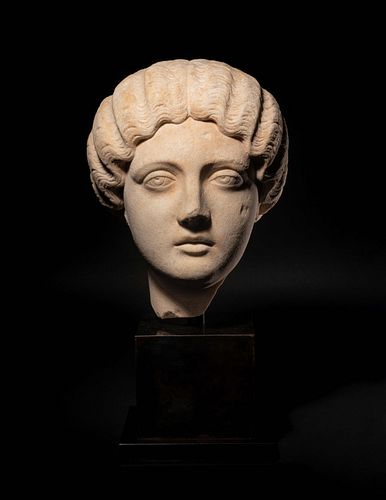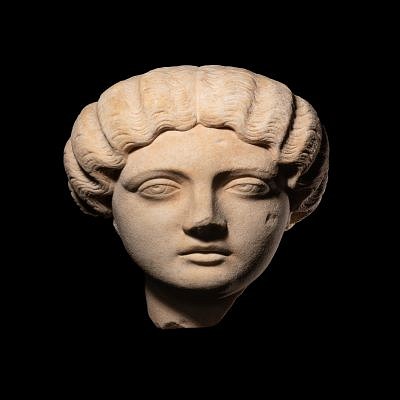A Roman Marble Portrait Head of the Empress Faustina Minor Height of marble 12 inches.
Lot 97
About Seller
Hindman
1338 West Lake Street
Chicago, IL 60607
United States
Recognized as the Midwest's leading fine art auctioneers, Hindman Auctioneers has built a worldwide reputation based on a full service approach to the auction business tailored to meet the individual needs of our clients. Coming from a variety of educational backgrounds, specialists bring years of e...Read more
Categories
Estimate:
$30,000 - $50,000
Absentee vs Live bid
Two ways to bid:
- Leave a max absentee bid and the platform will bid on your behalf up to your maximum bid during the live auction.
- Bid live during the auction and your bids will be submitted real-time to the auctioneer.
Bid Increments
| Price | Bid Increment |
|---|---|
| $0 | $25 |
| $500 | $50 |
| $1,000 | $100 |
| $2,000 | $250 |
| $5,000 | $500 |
| $10,000 | $1,000 |
| $20,000 | $2,500 |
| $50,000 | $5,000 |
| $100,000 | $10,000 |
About Auction
By Hindman
Nov 23, 2020
Set Reminder
2020-11-23 11:00:00
2020-11-23 11:00:00
America/New_York
Bidsquare
Bidsquare : Antiquities, Islamic & Indian Art
https://www.bidsquare.com/auctions/hindman-auctions/antiquities-islamic-indian-art-5912
Hindman Bidsquare@hindmanauctions.com
Hindman Bidsquare@hindmanauctions.com
- Lot Description
A Roman Marble Portrait Head of the Empress Faustina Minor
Circa 162-176 A.D.
Height of marble 12 inches.
Note:
Annia Galeria Faustina or Faustina Minor (the Younger) was born circa 125-130 A.D. She was one of four children of Emperor Antoninus Pius and Faustina Major (the Elder). Her great uncle, Emperor Hadrian, had betrothed her to Lucius Verus, but her father, who succeeded Hadrian as Emperor in 138 A.D., preferred his wife's nephew and Lucius Verus' adoptive brother, Marcus Aurelius, as Faustina's intended. Her father's preference ultimately prevailed, and in 145 A.D., Marcus Aurelius and Faustina were married. When Emperor Antoninus Pius died in 161 A.D., Marcus Aurelius ascended the Antonine throne alongside his adoptive brother, Lucius Verus, and Faustina was given the official title of Augusta or Empress (D. Kleiner, Roman Sculpture, New Haven, 1992, p. 278). Although the convention of multiple portrait types for members of the Imperial family is well-represented in the canon of Roman sculpture, the surviving portraits of Faustina Minor have been classified as adhering to a prodigious nine different types; only Septimius Severus, who was Emperor from 193 to 211 A.D., boasts more than Faustina Minor with ten documented portrait types (B.M. Levick, Faustina I and II Imperial Women of the Golden Age, Oxford, 2014, p. 277). This portrait head of Faustina Minor, which dates to circa 162-176 A.D., is representative of her eighth portrait type, the advent of which generally coincided with the birth of her twin sons Fulvus Antoninus and Commodus and her husband's ascension to power in 161 A.D. While her serene, oval face, almond-shaped eyes and centrally-parted braided chignon are evocative of her earlier portrait types, her face is €œimbued with a sense of maturity,€ a deliberate feature indicative of her status not only as Empress but as celebrated wife and mother of male heirs (D. Kleiner, pp. 278, 280). Faustina accompanied Marcus Aurelius on several military campaigns and was referred to by the Roman soldiers under his command as Mater Castrorum or €œMother of the Camp.€ She died in 175 A.D. while abroad at a military camp in Halala in Cappadocia, which was renamed Faustinopolis in her honor. Faustina was buried in the Mausoleum of Hadrian in Rome and was deified by her husband (D. Kleiner, p. 278).
Close surviving examples of this portrait type can be found at the Archaeological Museum of Istanbul (Inv. no. 5130; cf. K. Fittschen, Die Bildnistypen der Faustina Minor und die Fecunditas Augustae, Gottingen, 1982, pl. 41); and Rome's Capitoline Museum (Inv. no. 632; op cit. pl. 43).
Provenance:
Sotheby's, London, Antiquities, 9-10 July 1984, Lot 332.
Mahboubian Gallery of Ancient Art, London, 27 July 1984 (with invoice).
Property from a Private Collector, Winnetka, IllinoisHeight overall 18 inches.Condition
For condition inquiries please contact fdcr@hindmanauctions.com - Shipping Info
-
Please refer to https://hindmanauctions.com/shipping-packing
-
- Buyer's Premium



 EUR
EUR CAD
CAD AUD
AUD GBP
GBP MXN
MXN HKD
HKD CNY
CNY MYR
MYR SEK
SEK SGD
SGD CHF
CHF THB
THB

















